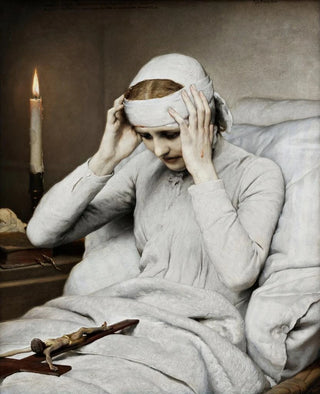Art print | The Ecstatic Virgin Anna Katharina Emmerich - Gabriel von Max


View from behind

Frame (optional)
In the rich and complex universe of art, some works transcend their era to become timeless witnesses of human spirituality. "The Ecstatic Virgin Anna Katharina Emmerich" by Gabriel von Max is one of those creations that, through its depth and intensity, invites reflection on faith, mysticism, and the human condition. This piece, imbued with a mystical atmosphere, transports us into the intimacy of a vision that resonates with devout believers and art enthusiasts alike. Through this art print, the viewer is invited to an immersive experience, where each brushstroke seems to vibrate with palpable emotion, making the work accessible to an ever-wider audience.
Style and uniqueness of the work
Gabriel von Max, an emblematic artist of the 19th century, stands out with a style that combines realism and symbolism. In "The Ecstatic Virgin Anna Katharina Emmerich," he deploys a palette of delicate colors that evoke softness and serenity, while emphasizing the depth of emotions. The figure of Anna Katharina Emmerich, depicted in a state of mystical trance, is highlighted by light effects that accentuate her devout face. The meticulous details, from the folds of her dress to her facial expressions, testify to a concern for detail and technical mastery that characterize von Max's art. This work does not merely depict a religious scene; it invites introspective contemplation, where the viewer is led to feel the spiritual depth of the moment.
The artist and his influence
Gabriel von Max, born in 1840 in Prague, is often regarded as a precursor to the symbolist movement. His fascination with mysticism and esotericism is reflected in many works, where he explores themes of spirituality and transcendence. By focusing on figures like Anna Katharina Emmerich, a German mystic known for her religious visions, von Max establishes a link between art and faith. His work has not only influenced his contemporaries but continues to inspire generations of artists seeking to capture the indic

Matte finish

View from behind

Frame (optional)
In the rich and complex universe of art, some works transcend their era to become timeless witnesses of human spirituality. "The Ecstatic Virgin Anna Katharina Emmerich" by Gabriel von Max is one of those creations that, through its depth and intensity, invites reflection on faith, mysticism, and the human condition. This piece, imbued with a mystical atmosphere, transports us into the intimacy of a vision that resonates with devout believers and art enthusiasts alike. Through this art print, the viewer is invited to an immersive experience, where each brushstroke seems to vibrate with palpable emotion, making the work accessible to an ever-wider audience.
Style and uniqueness of the work
Gabriel von Max, an emblematic artist of the 19th century, stands out with a style that combines realism and symbolism. In "The Ecstatic Virgin Anna Katharina Emmerich," he deploys a palette of delicate colors that evoke softness and serenity, while emphasizing the depth of emotions. The figure of Anna Katharina Emmerich, depicted in a state of mystical trance, is highlighted by light effects that accentuate her devout face. The meticulous details, from the folds of her dress to her facial expressions, testify to a concern for detail and technical mastery that characterize von Max's art. This work does not merely depict a religious scene; it invites introspective contemplation, where the viewer is led to feel the spiritual depth of the moment.
The artist and his influence
Gabriel von Max, born in 1840 in Prague, is often regarded as a precursor to the symbolist movement. His fascination with mysticism and esotericism is reflected in many works, where he explores themes of spirituality and transcendence. By focusing on figures like Anna Katharina Emmerich, a German mystic known for her religious visions, von Max establishes a link between art and faith. His work has not only influenced his contemporaries but continues to inspire generations of artists seeking to capture the indic






